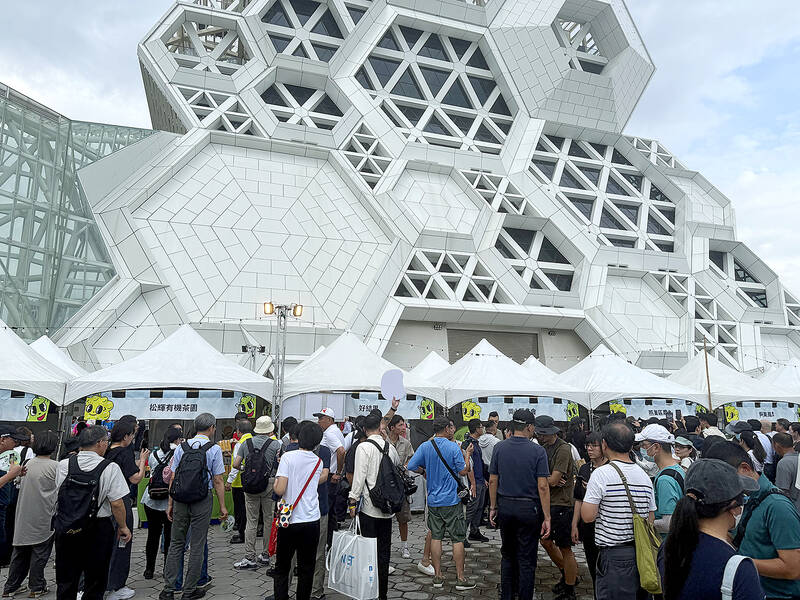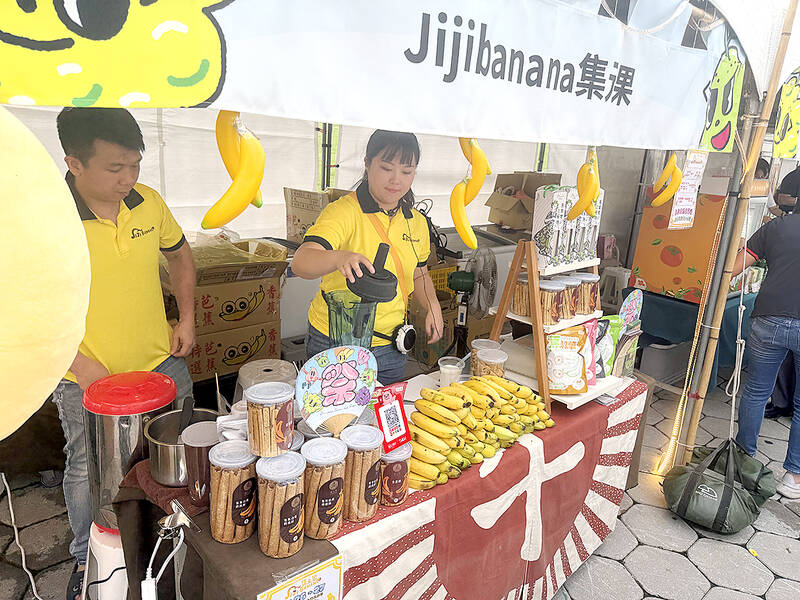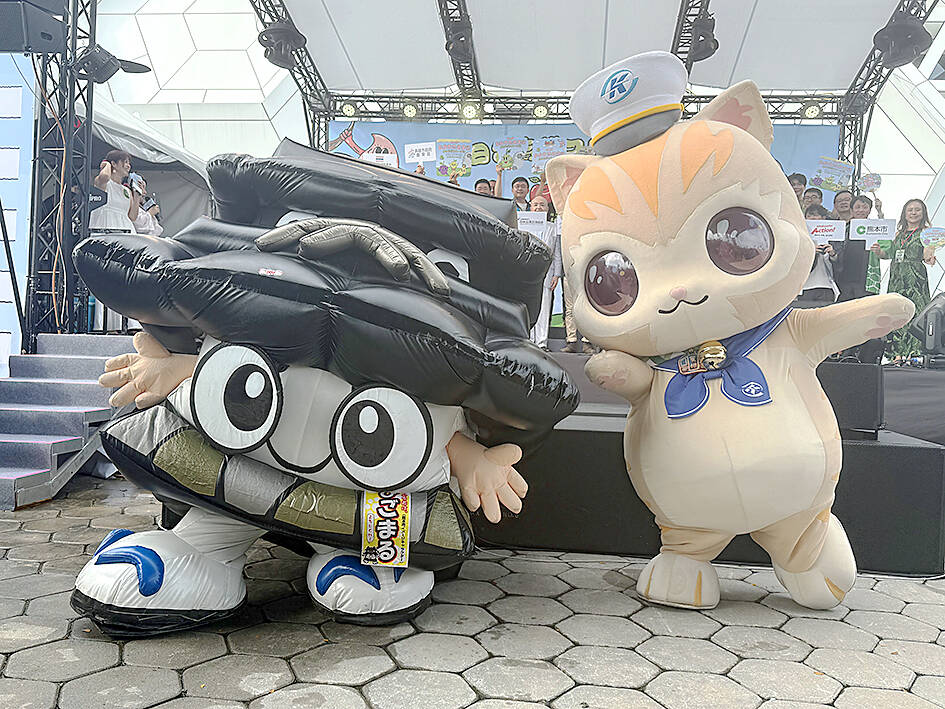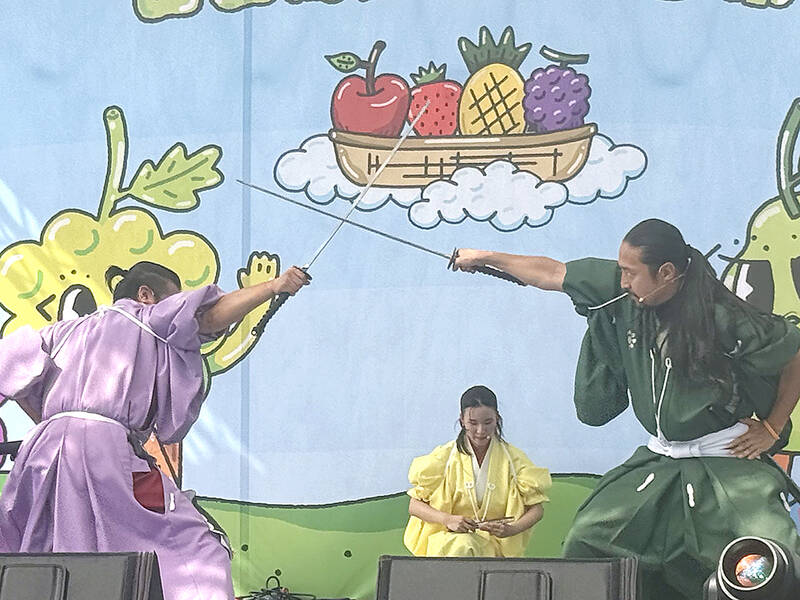The Japan-Taiwan Kaohsiung Fruit Festival shows how cities in both nations are finding ways to deepen relations in lieu of formal diplomatic ties
By Julien Oeuillet / Contributing reporter in Kaohsiung
The latest edition of the Japan-Taiwan Fruit Festival took place in Kaohsiung on July 26 and 27.
During the weekend, the dockside in front of the iconic Music Center was full of food stalls, and a stage welcomed performers.
After the French-themed festival earlier in the summer, this is another example of Kaohsiung’s efforts to make the city more international.

Photo: Julien Oeuillet
The event was originally initiated by the Japan-Taiwan Exchange Association in 2022.
The goal was “to commemorate [the association’s] 50th anniversary and further strengthen the longstanding friendship between Japan and Taiwan,” says Kaohsiung Director-General of International Affairs Chang Yen-ching (張硯卿). “The first two editions were held in Taipei, and in 2024, the festival was hosted in Kaohsiung for the first time, receiving overwhelmingly positive feedback.”
It makes sense for Kaohsiung to host a Japan-themed event, as it is arguably the city with the most Japanese influence in Taiwan.

Photo: Julien Oeuillet
Under its past name, Takao, Kaohsiung was developed from a small harbor into a large industrial base under Japanese rule, leaving behind landmarks and buildings as well as a strong cultural connection.
“Because Kaohsiung has a long history of exchange between Japan and Taiwan, it is an ideal place to share and enjoy Japanese and Taiwanese culture,” says Kenichiro Koreeda, Deputy Director-General of the Kaohsiung Office of the Japan-Taiwan Exchange Association.
Last year’s edition of the festival was widely seen as successful and attracted even larger crowds this year, with 110,000 visitors according to Kaohsiung city authorities.

Photo: Julien Oeuillet
“We noticed that, due to high popularity, the venue felt cramped last year,” Koreeda says. “This year, we adjusted the layout of the booths to create more space, allowing visitors to enjoy the festival more comfortably.”
The festival is a symbol of what Chang refers to as cooperation “through people-to-people interaction,” as well as direct exchanges between cities.
Although Japan’s central government is absent, nine Japanese cities had booths at the festival, and visitors were introduced to the gastronomic products, economic opportunities, and tourist sites of various Japanese regions represented by their own local authorities.

Photo: Julien Oeuillet
The theme of fruits makes the event stand out from similar festivals, which often focus on culture. Chang says it aims to “agricultural exchange and the marketing of premium fruits from both sides… This festival goes beyond food and entertainment, it reflects Kaohsiung’s commitment to international friendship and sustainable agricultural promotion.”
She adds that it “strengthens our relationships with Japanese cities, provides a platform for local farmers and young entrepreneurs… It’s also a celebration of our identity as a modern, welcoming port city with deep roots in fruit production.”
Indeed, the nearby Banana Pier is so named because it used to be where bananas were transited in wide hangars now turned into malls and cultural spaces.
Koreeda says that “Kaohsiung is a major market for food products. This makes it an ideal place to introduce high-quality Japanese agricultural, fishery and food products to Taiwanese consumers.”
He comments on the challenge posed by creating an outdoor event centered on fruits in the middle of Kaohsiung’s tropical summer: “dealing with the seasonal limitations of Japanese fruits, as Japan has four distinct seasons; to overcome this challenge, we made a special effort to offer a wide variety of fruit-related products, not only fresh fruits, but also processed goods and fruit-based alcoholic beverages.”
In total, there were nearly 100 booths, and 16 performance groups succeeded each other on stage.
These included a blade martial arts demonstration, a duo blending modern pop with traditional Japanese instruments and dancing groups that involved the audience.
“Last year, as part of our efforts to introduce Japanese culture, we held a Bon Odori dance event with Japanese and Taiwanese residents living in south Taiwan,” Koreeda says. “This year, we invited dancers from Mutsu City, Aomori Prefecture in Japan to perform authentic Japanese dances.”
One of the main challenges was coordinating across many sectors and cities, both in Taiwan and Japan. Chang says, “balancing cultural performances, market logistics, international guest coordination, and weather considerations required strong teamwork across multiple government departments and our Japanese partners.”
The event ended with nightly concerts. “Hearing the phrase ‘I love Kaohsiung!’ shouted enthusiastically by Japanese performers on stage reminded me how powerful events like this are in connecting hearts across borders,” Chang says. Koreeda adds: “It’s truly delightful to know that our festival brought joy and smiles to many.”


AloJapan.com